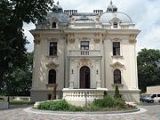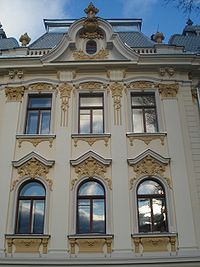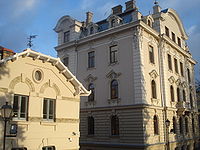
Vileišis Palace
Encyclopedia
Vileišis Palace is a Neo-baroque style architectural ensemble in Vilnius
, Lithuania
, built for Petras Vileišis
. Vileišis was a prominent Lithuania
n engineer, political activist, publisher, and philanthropist who commissioned the palace in 1904 and supervised its construction. The ensemble consists of a main house, a guesthouse, and an outbuilding. It currently houses the Institute of Lithuanian Literature and Folklore. It was renovated during the early 2000s.
 The palace's architect, August Klein
The palace's architect, August Klein
, created two blueprints, one Neo-classical
and the other Neo-baroque
. Vileišis selected the Neo-baroque style, because of the site's proximity to the baroque St. Peter and St. Paul's Church
.
Work on the ensemble began in 1904. According to witnesses, the lime
used in its construction was diluted with separated milk rather than water. Some materials not customarily used at the time were employed, such as ferroconcrete. Building materials were bought from Finland
and the Netherlands
. The project was completed in 1906. It was situated on a one-half hectare
site, surrounded by a wrought iron
fence and elaborately landscaped.
The main palace has two floors. Petras Vileišis' office and an ante-room were located on the first floor, as were a hallway, two drawing rooms and a dining room. The large chandelier in the vestibule
was a gift from the workers at the Vilija factory. A terrace
between the first and second floors was surrounded by a balustrade. The family's bedrooms were located on the second floor, while servants' quarters were located in the attic under the mansard roof. The interior was decorated in Neo-classical and Rococo
styles, featuring crown molding
, sculptural elements, and pastel tiles. Portraits, busts, and bas-reliefs of Lithuanian literary and cultural figures were displayed throughout the palace. The ensemble's guesthouse is three stories tall, with two stairways. Vileišis established a printing press
The ensemble's guesthouse is three stories tall, with two stairways. Vileišis established a printing press
for the Vilniaus žinios
, the first legal Lithuanian-language daily newspaper printed in Vilnius, in the basement. The newspaper's editorial and administrative offices were on the first floor; other offices were located on its second floor. On 1907 January 9, the first Lithuanian Art Exhibition was held at the guesthouse, presenting the artwork of Mikalojus Konstantinas Čiurlionis
and Antanas Žmuidzinavičius
. It was the first exhibition of Čiurlionis' paintings.
The ensemble's outbuilding, constructed in yellow brick, is two stories tall. This building was used as a book bindery
and as living quarters for servants.
Petras Vileišis and his family lived in the palace until World War I
. In 1926, Vileišis died and the palace was inherited by his daughter, Elena Vileišytė. In 1931, she sold the entire ensemble to the Lithuanian organization "Rytas" for 55,000 US dollars. From 1941 to 1990 the palace housed the Lithuanian literature and Lithuanian language institutes. Since 1990, it has housed the Institute of Lithuanian Literature and Folklore.
 The palace underwent three years of renovation in the early 2000s and was re-opened in 2007. Since it was structurally sound, its restoration was largely cosmetic. During the renovation, many significant historic documents were found hidden in the palace walls. However, the long-missing copies of the Act of Independence of Lithuania
The palace underwent three years of renovation in the early 2000s and was re-opened in 2007. Since it was structurally sound, its restoration was largely cosmetic. During the renovation, many significant historic documents were found hidden in the palace walls. However, the long-missing copies of the Act of Independence of Lithuania
, signed in 1918, were not found, despite a popular belief that they were hidden in the palace. Petras Vileišis' brother, Jonas Vileišis
, was one of the Act's signatories
.
Vilnius
Vilnius is the capital of Lithuania, and its largest city, with a population of 560,190 as of 2010. It is the seat of the Vilnius city municipality and of the Vilnius district municipality. It is also the capital of Vilnius County...
, Lithuania
Lithuania
Lithuania , officially the Republic of Lithuania is a country in Northern Europe, the biggest of the three Baltic states. It is situated along the southeastern shore of the Baltic Sea, whereby to the west lie Sweden and Denmark...
, built for Petras Vileišis
Petras Vileišis
Petras Vileišis was a prominent Lithuanian engineer, political activist, and philanthropist.His early schooling took place in Panevežys. He then completed his secondary education at the Šiauliai Gymnasium, graduating with honors. In 1874, he completed his studies at St. Petersburg University, with...
. Vileišis was a prominent Lithuania
Lithuania
Lithuania , officially the Republic of Lithuania is a country in Northern Europe, the biggest of the three Baltic states. It is situated along the southeastern shore of the Baltic Sea, whereby to the west lie Sweden and Denmark...
n engineer, political activist, publisher, and philanthropist who commissioned the palace in 1904 and supervised its construction. The ensemble consists of a main house, a guesthouse, and an outbuilding. It currently houses the Institute of Lithuanian Literature and Folklore. It was renovated during the early 2000s.
History

August Klein
August Klein was an architect of German origin, who worked in Vilnius. from 1891 till 1896 studied in Saint Petersburg. Among his prominent works are Vileišis Palace, completed in 1906....
, created two blueprints, one Neo-classical
Neoclassicism
Neoclassicism is the name given to Western movements in the decorative and visual arts, literature, theatre, music, and architecture that draw inspiration from the "classical" art and culture of Ancient Greece or Ancient Rome...
and the other Neo-baroque
Neo-baroque
The Baroque Revival or Neo-baroque was an architectural style of the late 19th century. The term is used to describe architecture which displays important aspects of Baroque style, but is not of the Baroque period proper—i.e., the 17th and 18th centuries.Some examples of Neo-baroque architecture:*...
. Vileišis selected the Neo-baroque style, because of the site's proximity to the baroque St. Peter and St. Paul's Church
St. Peter and St. Paul's Church, Vilnius
St. Peter and St. Paul's Church in Vilnius is a Roman Catholic church located in the Antakalnis neighbourhood of the city. Its interior has masterful compositions of stucco mouldings by Giovanni Pietro Perti and ornamentation by Giovanni Maria Galli of Milan, and is considered a Lithuanian Baroque...
.
Work on the ensemble began in 1904. According to witnesses, the lime
Lime (mineral)
Lime is a general term for calcium-containing inorganic materials, in which carbonates, oxides and hydroxides predominate. Strictly speaking, lime is calcium oxide or calcium hydroxide. It is also the name for a single mineral of the CaO composition, occurring very rarely...
used in its construction was diluted with separated milk rather than water. Some materials not customarily used at the time were employed, such as ferroconcrete. Building materials were bought from Finland
Finland
Finland , officially the Republic of Finland, is a Nordic country situated in the Fennoscandian region of Northern Europe. It is bordered by Sweden in the west, Norway in the north and Russia in the east, while Estonia lies to its south across the Gulf of Finland.Around 5.4 million people reside...
and the Netherlands
Netherlands
The Netherlands is a constituent country of the Kingdom of the Netherlands, located mainly in North-West Europe and with several islands in the Caribbean. Mainland Netherlands borders the North Sea to the north and west, Belgium to the south, and Germany to the east, and shares maritime borders...
. The project was completed in 1906. It was situated on a one-half hectare
Hectare
The hectare is a metric unit of area defined as 10,000 square metres , and primarily used in the measurement of land. In 1795, when the metric system was introduced, the are was defined as being 100 square metres and the hectare was thus 100 ares or 1/100 km2...
site, surrounded by a wrought iron
Wrought iron
thumb|The [[Eiffel tower]] is constructed from [[puddle iron]], a form of wrought ironWrought iron is an iron alloy with a very low carbon...
fence and elaborately landscaped.
The main palace has two floors. Petras Vileišis' office and an ante-room were located on the first floor, as were a hallway, two drawing rooms and a dining room. The large chandelier in the vestibule
Vestibule (architecture)
A vestibule is a lobby, entrance hall, or passage between the entrance and the interior of a building.The same term can apply to structures in modern or ancient roman architecture. In modern architecture vestibule typically refers to a small room or hall between an entrance and the interior of...
was a gift from the workers at the Vilija factory. A terrace
Terrace (building)
A terrace is an outdoor, occupiable extension of a building above ground level. Although its physical characteristics may vary to a great degree, a terrace will generally be larger than a balcony and will have an "open-top" facing the sky...
between the first and second floors was surrounded by a balustrade. The family's bedrooms were located on the second floor, while servants' quarters were located in the attic under the mansard roof. The interior was decorated in Neo-classical and Rococo
Rococo
Rococo , also referred to as "Late Baroque", is an 18th-century style which developed as Baroque artists gave up their symmetry and became increasingly ornate, florid, and playful...
styles, featuring crown molding
Crown molding
Crown molding encapsulates a large family of moldings which are designed to gracefully flare out to a finished top edge. Crown molding is generally used for capping walls, pilasters, and cabinets, and is used extensively in the creation of interior and exterior cornice assemblies and door and...
, sculptural elements, and pastel tiles. Portraits, busts, and bas-reliefs of Lithuanian literary and cultural figures were displayed throughout the palace.

Printing press
A printing press is a device for applying pressure to an inked surface resting upon a print medium , thereby transferring the ink...
for the Vilniaus žinios
Vilniaus žinios
Vilniaus žinios was a short-lived newspaper published in Vilnius, Lithuania. It was the first legal Lithuanian-language daily newspaper to appear after the Lithuanian press ban was lifted on May 7, 1904.-History:...
, the first legal Lithuanian-language daily newspaper printed in Vilnius, in the basement. The newspaper's editorial and administrative offices were on the first floor; other offices were located on its second floor. On 1907 January 9, the first Lithuanian Art Exhibition was held at the guesthouse, presenting the artwork of Mikalojus Konstantinas Čiurlionis
Mikalojus Konstantinas Ciurlionis
Mikalojus Konstantinas Čiurlionis , also known as M. K. Čiurlionis was a Lithuanian painter and composer. Čiurlionis contributed to symbolism and art nouveau and was representative of the fin de siècle epoch. During his short life he composed about 250 pieces of music and created about 300 paintings...
and Antanas Žmuidzinavičius
Antanas Žmuidzinavicius
Antanas Žmuidzinavičius was a Lithuanian painter and art collector. Sometimes he used Antanas Žemaitis as his pen name....
. It was the first exhibition of Čiurlionis' paintings.
The ensemble's outbuilding, constructed in yellow brick, is two stories tall. This building was used as a book bindery
Bindery
Bindery refers to a studio, workshop or factory where sheets of paper are fastened together to make books, but also where gold and other decorative elements are added to the exterior of books, where boxes or slipcases for books are made and where the restoration of books is carried out.-Overview:A...
and as living quarters for servants.
Petras Vileišis and his family lived in the palace until World War I
World War I
World War I , which was predominantly called the World War or the Great War from its occurrence until 1939, and the First World War or World War I thereafter, was a major war centred in Europe that began on 28 July 1914 and lasted until 11 November 1918...
. In 1926, Vileišis died and the palace was inherited by his daughter, Elena Vileišytė. In 1931, she sold the entire ensemble to the Lithuanian organization "Rytas" for 55,000 US dollars. From 1941 to 1990 the palace housed the Lithuanian literature and Lithuanian language institutes. Since 1990, it has housed the Institute of Lithuanian Literature and Folklore.
The Palace today

Act of Independence of Lithuania
The Act of Independence of Lithuania or Act of February 16 was signed by the Council of Lithuania on February 16, 1918, proclaiming the restoration of an independent State of Lithuania, governed by democratic principles, with Vilnius as its capital. The Act was signed by all twenty...
, signed in 1918, were not found, despite a popular belief that they were hidden in the palace. Petras Vileišis' brother, Jonas Vileišis
Jonas Vileišis
Jonas Vileišis was a Lithuanian lawyer, politician, and diplomat.-Early life and career:Vileišis was born in Mediniai, near Pasvalys. In 1892 he graduated from the Šiauliai gymnasium. During 1892-1894, he studied physics and mathematics at Saint Petersburg University. Later he transferred to the...
, was one of the Act's signatories
Signatories of the Act of Independence of Lithuania
The signatories of the Act of Independence of Lithuania were the twenty Lithuanian men who signed the Act of Independence of Lithuania on February 16, 1918. The signatories were elected to the Council of Lithuania by the Vilnius Conference in September 1917 and entrusted with the mission of...
.

